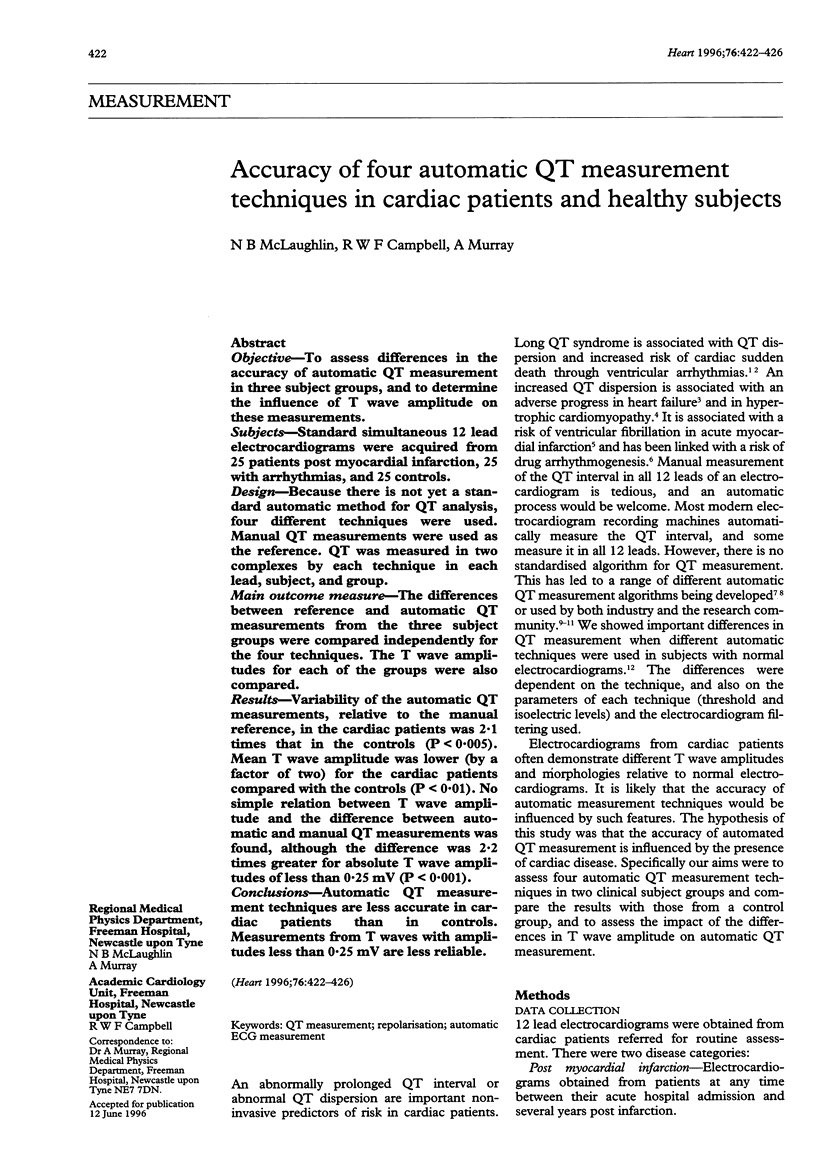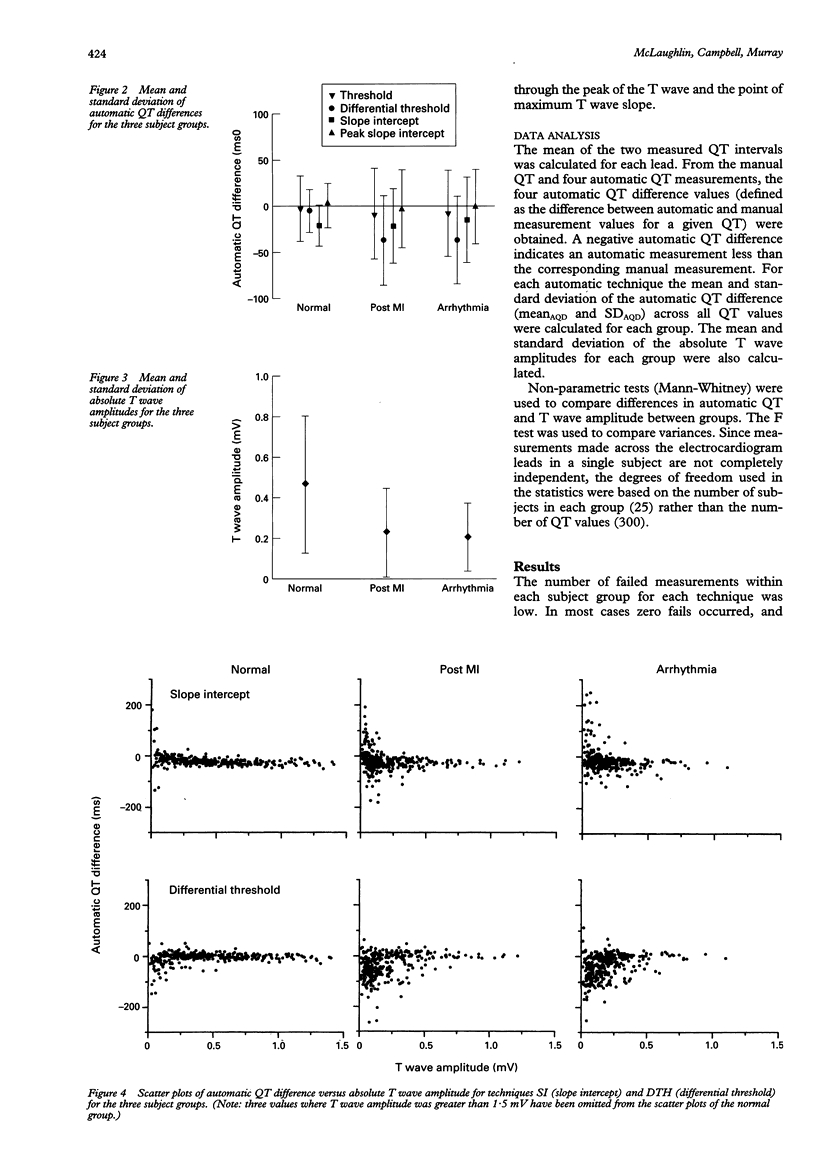Abstract
OBJECTIVE: To assess differences in the accuracy of automatic QT measurement in three subject groups, and to determine the influence of T wave amplitude on these measurements. SUBJECTS: Standard simultaneous 12 lead electrocardiograms were acquired from 25 patients post myocardial infarction, 25 with arrhythmias, and 25 controls. DESIGN: Because there is not yet a standard automatic method for QT analysis, four different techniques were used. Manual QT measurements were used as the reference. QT was measured in two complexes by each technique in each lead, subject, and group. MAIN OUTCOME MEASURE: The differences between reference and automatic QT measurements from the three subject groups were compared independently for the four techniques. The T wave amplitudes for each of the groups were also compared. RESULTS: Variability of the automatic QT measurements, relative to the manual reference, in the cardiac patients was 2.1 times that in the controls (P < 0.005). Mean T wave amplitude was lower (by a factor of two) for the cardiac patients compared with the controls (P < 0.01). No simple relation between T wave amplitude and the difference between automatic and manual QT measurements was found, although the difference was 2.2 times greater for absolute T wave amplitudes of less than 0.25 mV (P < 0.001). CONCLUSIONS: Automatic QT measurement techniques are less accurate in cardiac patients than in controls. Measurements from T waves with amplitudes less than 0.25 mV are less reliable.
Full text
PDF




Selected References
These references are in PubMed. This may not be the complete list of references from this article.
- Barr C. S., Naas A., Freeman M., Lang C. C., Struthers A. D. QT dispersion and sudden unexpected death in chronic heart failure. Lancet. 1994 Feb 5;343(8893):327–329. doi: 10.1016/s0140-6736(94)91164-9. [DOI] [PubMed] [Google Scholar]
- Buja G., Miorelli M., Turrini P., Melacini P., Nava A. Comparison of QT dispersion in hypertrophic cardiomyopathy between patients with and without ventricular arrhythmias and sudden death. Am J Cardiol. 1993 Oct 15;72(12):973–976. doi: 10.1016/0002-9149(93)91118-2. [DOI] [PubMed] [Google Scholar]
- Day C. P., McComb J. M., Campbell R. W. QT dispersion: an indication of arrhythmia risk in patients with long QT intervals. Br Heart J. 1990 Jun;63(6):342–344. doi: 10.1136/hrt.63.6.342. [DOI] [PMC free article] [PubMed] [Google Scholar]
- Hii J. T., Wyse D. G., Gillis A. M., Duff H. J., Solylo M. A., Mitchell L. B. Precordial QT interval dispersion as a marker of torsade de pointes. Disparate effects of class Ia antiarrhythmic drugs and amiodarone. Circulation. 1992 Nov;86(5):1376–1382. doi: 10.1161/01.cir.86.5.1376. [DOI] [PubMed] [Google Scholar]
- Laguna P., Thakor N. V., Caminal P., Jané R., Yoon H. R., Bayés de Luna A., Marti V., Guindo J. New algorithm for QT interval analysis in 24-hour Holter ECG: performance and applications. Med Biol Eng Comput. 1990 Jan;28(1):67–73. doi: 10.1007/BF02441680. [DOI] [PubMed] [Google Scholar]
- Merri M., Benhorin J., Alberti M., Locati E., Moss A. J. Electrocardiographic quantitation of ventricular repolarization. Circulation. 1989 Nov;80(5):1301–1308. doi: 10.1161/01.cir.80.5.1301. [DOI] [PubMed] [Google Scholar]
- Mirvis D. M. Spatial variation of QT intervals in normal persons and patients with acute myocardial infarction. J Am Coll Cardiol. 1985 Mar;5(3):625–631. doi: 10.1016/s0735-1097(85)80387-9. [DOI] [PubMed] [Google Scholar]
- Murray A., McLaughlin N. B., Bourke J. P., Doig J. C., Furniss S. S., Campbell R. W. Errors in manual measurement of QT intervals. Br Heart J. 1994 Apr;71(4):386–390. doi: 10.1136/hrt.71.4.386. [DOI] [PMC free article] [PubMed] [Google Scholar]
- O'Donnell J., Lovelace D. E., Knoebel S. B., McHenry P. L. Behavior of the terminal T wave during exercise in normal subjects, patients with symptomatic coronary artery disease and apparently healthy subjects with abnormal ST segment depression. J Am Coll Cardiol. 1985 Jan;5(1):78–84. doi: 10.1016/s0735-1097(85)80087-5. [DOI] [PubMed] [Google Scholar]
- Somberg J., Tepper D., Wynn J. Prolonged repolarization: a historical perspective. Am Heart J. 1985 Feb;109(2):395–398. doi: 10.1016/0002-8703(85)90625-8. [DOI] [PubMed] [Google Scholar]


